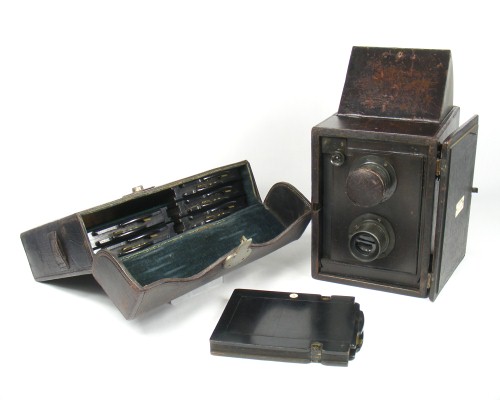Portable Divided Camera
Ross & Company
| Plate / Film Size: | ¼ plate |
| Lens: | Ross Rapid Symmetrical Lenses |
| Shutter: | Absent, but references suggest that a small Thornton Pickard roller blind shutter would be used |
| Movements: | None |
| Dimensions (w x h x l): | |
| Date of this Example: | c1891 |
| Serial Number: | Serial 574 stamped into leather on underside at rear |
| Availability: |
|
| Inventory Number: | 224 |
|
Photos copyright © 2012 David Purcell. Do not use without permission. |
Description
This is a good example of this early Ross Portable Divided camera. The Ross Portable Divided camera has a hand stitched black hide covering over the wooden body (inside faces painted black), which is in very good condition. The only obvious fault is that there is no means by which to lift the reflex finder - references suggest this may have been a simple flap of hide fixed by screws to the lid of the finder. The camera came with a full set of black ebonised plate holders in their own case.
The lenses have no markings other than their f number scale (aperture set by a rotating lever on the side of lens - in both cases). The main lens numbered 'I', the viewing lens is numbered 'II'.
The front door of the camera is hinged such that it can fold back through approximately 270 degrees to rest by the side of the camera. Each of the hinges are held in place by a latch on the side of the camera. Releasing both latches allows the door to be removed completely. Each hinge is located by virtue of three raised pin heads on the camera body, which correspond to three holes in the hinge plate. Once positioned, the bar is then used to lock the hinge plate in position.
The camera came complete with a high quality hide case containing 6 black ¼ plate DDS. The case is in excellent condition (but will not latch shut), lined with green velvet, but has no makers mark. However the finish and quality are comparable to that of the hide applied to the camera itself. The DDS are numbered, but again carry no other makers marks.
The camera has had some restoration work. The top face had a PREMO handle screwed to it when originally listed (see below), which has since been removed, but the marks remain. When first listed the lenses had spacers added, but these have also been removed (and so the mounting screws are not original).
Notes
This camera is identified as the "Portable Twin Lens Camera" from 1895.
A good reference for the cameras, including a copy of a contemporary Ross advert, is to be found in An Age of Cameras by Edward Holmes [7]. This shows the early example, as here, and the later version where the front door was split and opened forwards to form the supports for the lens board to move forward, thereby allowing the overall size of the camera to be reduced.
I had originally bid on this on eBay in about February 2004, but lost out to another collector. The plateholders were listed separately and I won those, but gave them up to the other buyer in order to keep them with the camera. The camera and DDS were subsequently re-listed along with a boxed T-P shutter that had been added to the kit, though the aperture is the wrong size for the camera lens. I won the set for less than the seller originally paid for just the camera, which just goes to illustrate the uncertainties and fickle nature of buying and selling on eBay!
A De Luxe version of this camera also exists with brown hide covering, polished mahogany internal faces and polished aluminium fittings.

![[ ]](../../images/unchecked.png)
![[x]](../../images/checked.png)







